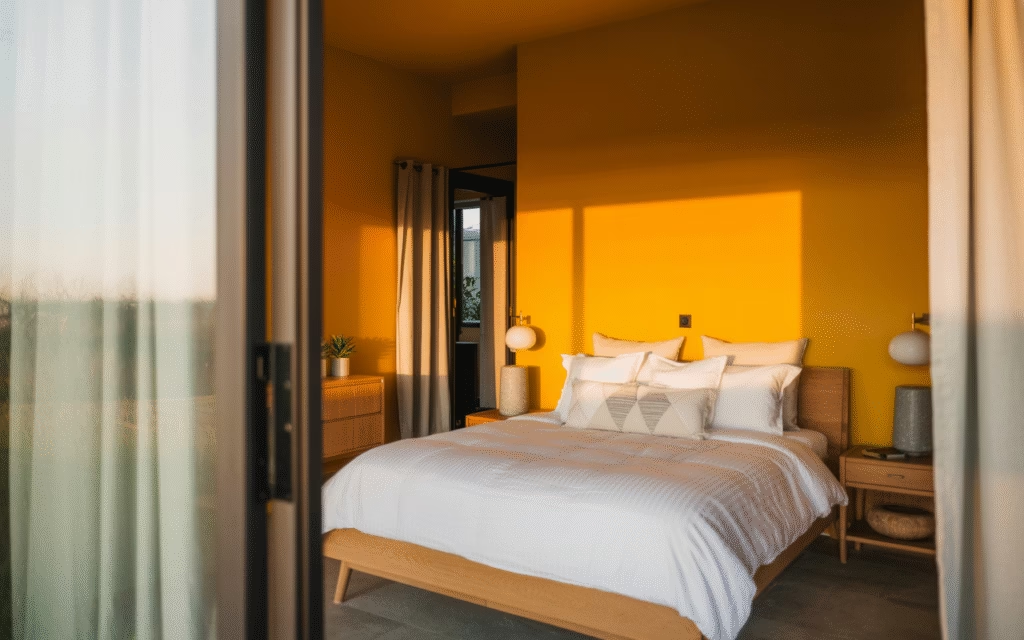I’ll be honest when I first decided to work with yellow in a bedroom, I was terrified. Yellow can go wrong so fast. Too bright and you can’t sleep. Too dull and the room feels dingy. But after helping clients transform their bedrooms with various shades of yellow over the years, I’ve learned exactly what works and what doesn’t. Yellow bedrooms have this incredible ability to make you wake up feeling energized while still being cozy enough for relaxation. The trick is knowing which shade to use and where.
In this guide, I’m sharing 15 approaches I’ve personally tested or implemented. You’ll learn specific paint colors, furniture pairings, and lighting techniques that create stunning yellow bedrooms without the common pitfalls.
Soft Butter Yellow Walls with White Trim
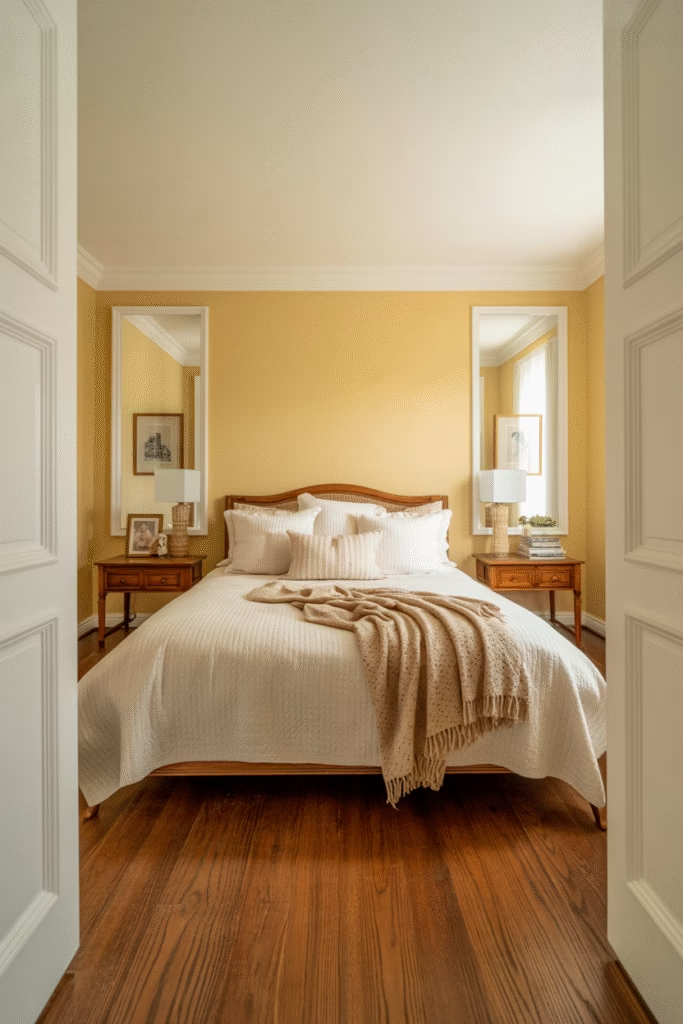
This is my go-to recommendation for beginners because it’s nearly impossible to mess up. I’m talking about shades like Benjamin Moore’s “Hawthorne Yellow” or Farrow & Ball’s “Dayroom Yellow”—colors that read as creamy rather than bright.
Paint your walls in this soft butter shade and keep all trim, doors, and crown molding in crisp white. The contrast creates definition without being harsh. I’ve found this works especially well in bedrooms with limited natural light because the yellow reflects what light you have without feeling dark.
Pro tip: Test your paint sample on both the wall that gets morning sun and the one that doesn’t. Yellow can look completely different depending on light exposure.
For flooring, medium to dark wood tones work beautifully. I installed 19mm (3/4 inch) oak hardwood in a client’s room last year with this exact color scheme, and the warm wood balanced the cool white trim perfectly.
Bold Marigold Accent Wall
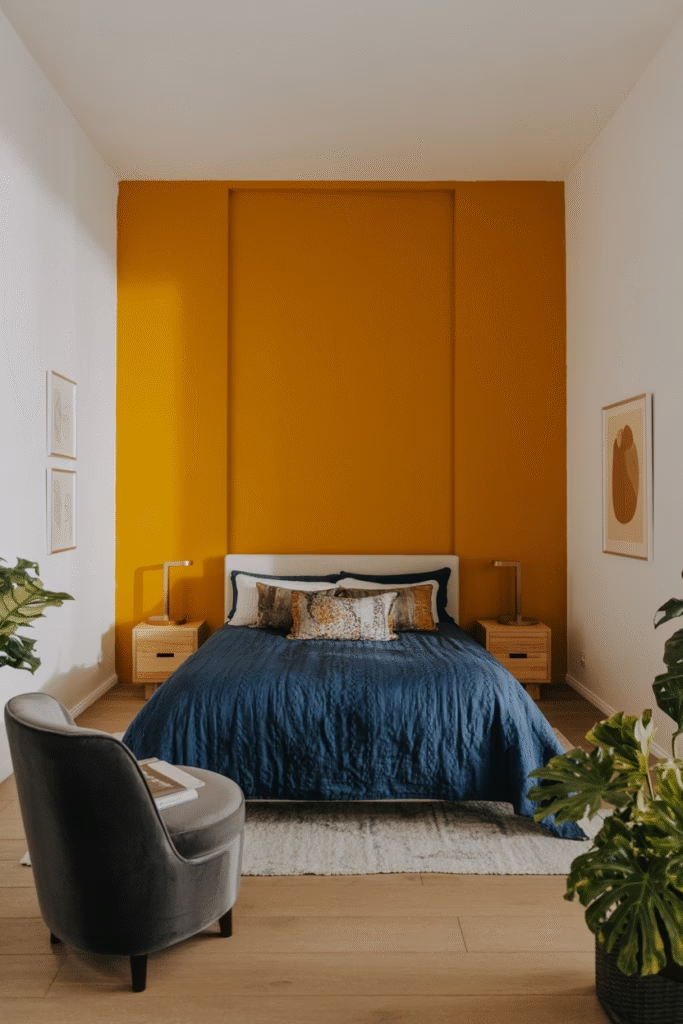
If full yellow walls feel too committed, try one accent wall in a deeper marigold shade. I position this behind the bed about 80% of the time—it creates a natural focal point and doesn’t overwhelm since you’re lying down facing away from it most of the time.
Choose a color with some orange undertones like “Golden Straw” or “Amber Waves.” These deeper yellows pair incredibly well with navy blue bedding or charcoal gray furniture. In my own guest room, I used this approach with a marigold accent wall and kept the other three walls in warm white. Guests always comment on how cheerful it feels without being too intense.
The key is keeping the rest of your color palette neutral. White bedding, natural wood nightstands, and maybe one piece of navy or forest green as an accent color. That’s it.
Pale Yellow Ceiling with Neutral Walls
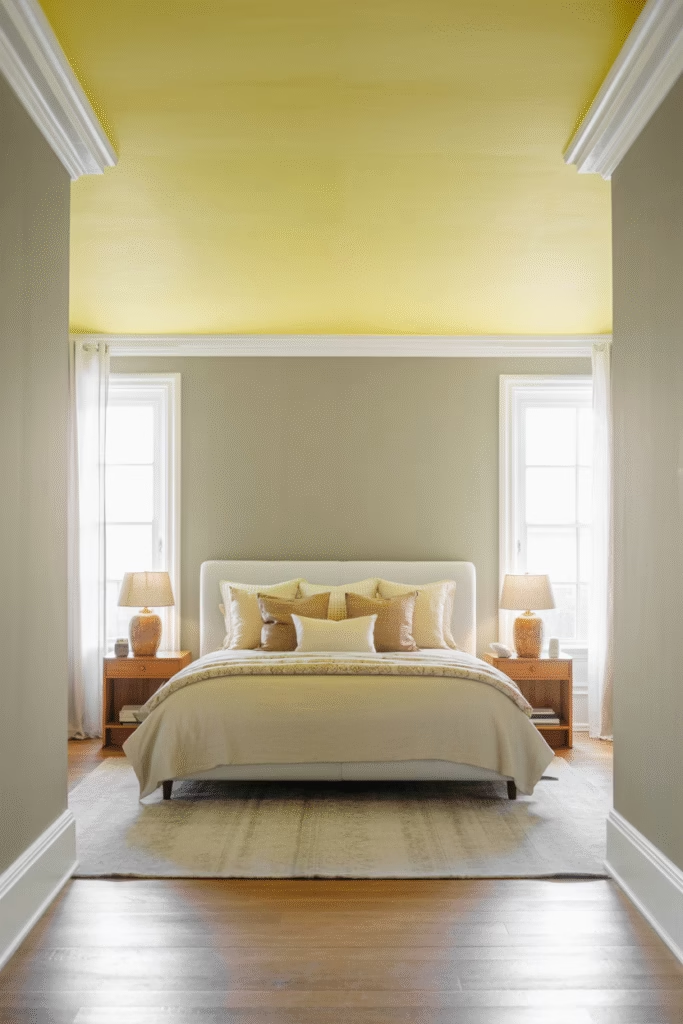
This is an unexpected approach that I love for its subtlety. Most people never look up, which makes a pale yellow ceiling a delightful surprise. It’s like having gentle sunshine overhead even on cloudy days.
I recommend keeping walls in soft gray, greige, or warm white when you do this. The ceiling color should be barely-there yellow—think “Lemon Ice” or “Moonlight.” Paint it the same finish as your walls, typically matte or eggshell, never glossy.
This technique works particularly well in bedrooms with high ceilings (2.7m/9 feet or taller). Lower ceilings can feel closed in with color overhead, but in taller rooms, it adds warmth without reducing the sense of space.
Mustard Yellow Bedding as the Color Base
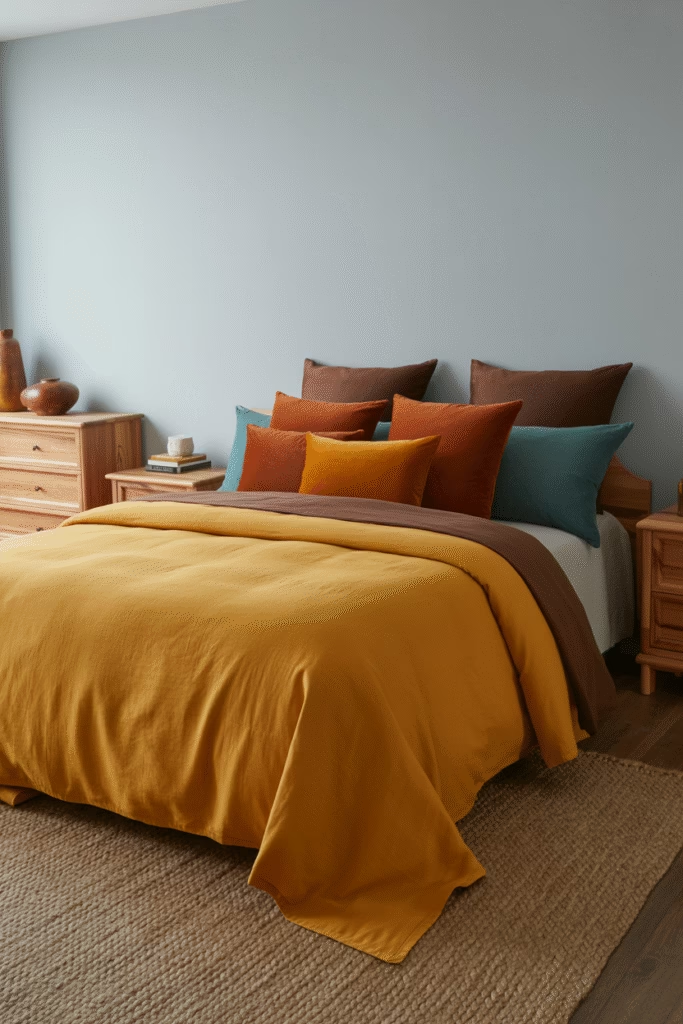
Sometimes the walls don’t need to be yellow at all. I’ve created stunning yellow bedrooms by starting with mustard or golden yellow bedding against white or light gray walls.
Choose a duvet cover in a rich mustard shade with 200+ thread count cotton—quality matters here because the bedding becomes your room’s centerpiece. Layer it with cream or tan sheets and add throw pillows in complementary colors like burnt orange, deep teal, or chocolate brown.
This approach gives you flexibility. Swap the bedding seasonally or when you’re ready for a change without repainting. I keep two sets for my own bedroom—golden yellow for fall and winter, and pale butter yellow for spring and summer.
Avoid this: Don’t match your curtains exactly to the bedding. It looks too coordinated and dated. Instead, choose curtains one or two shades lighter or in a neutral tone.
Vintage Yellow with Brass Accents
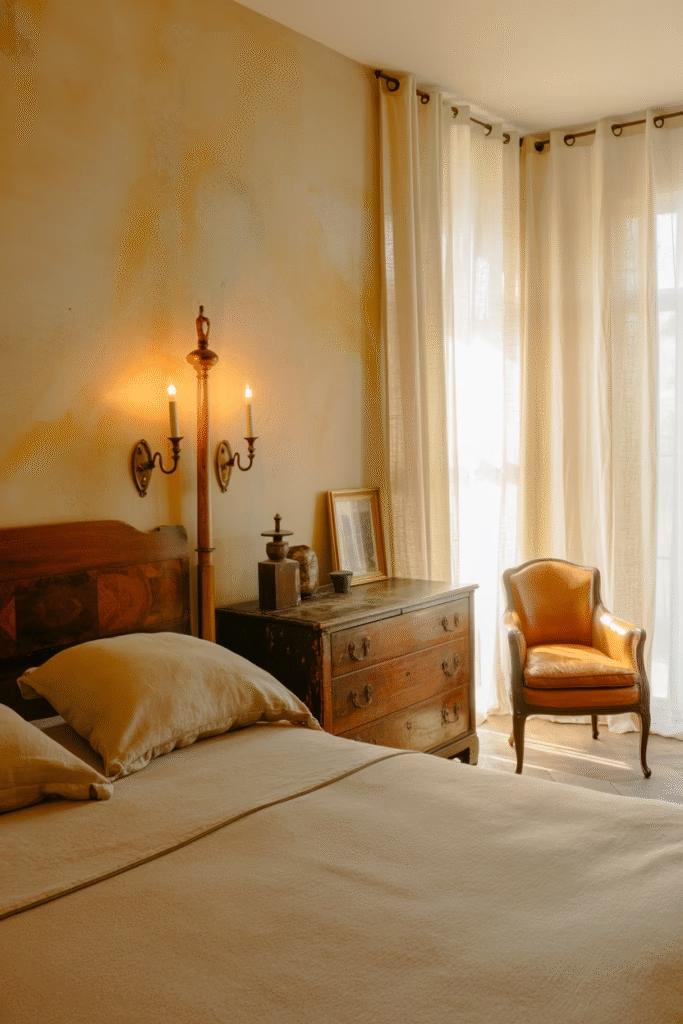
This is my favorite style for creating a sophisticated, collected-over-time look. Start with walls in a slightly faded yellow—colors labeled “vintage,” “aged,” or “antique” work well. These have gray undertones that prevent them from looking too cheerful.
Layer in brass lighting fixtures, drawer pulls, and picture frames. The warm metal tones complement yellow beautifully. I sourced vintage brass wall sconces from a local flea market for around ₹3,000 ($36) each and they transformed the entire feel of the room.
Add worn leather furniture, aged wood pieces, and linen textiles in cream or oatmeal. The goal is creating a space that feels like it’s been loved for decades. This style works exceptionally well in older homes with architectural details like picture rails or deep baseboards.
Lemon Yellow with Crisp White Furniture
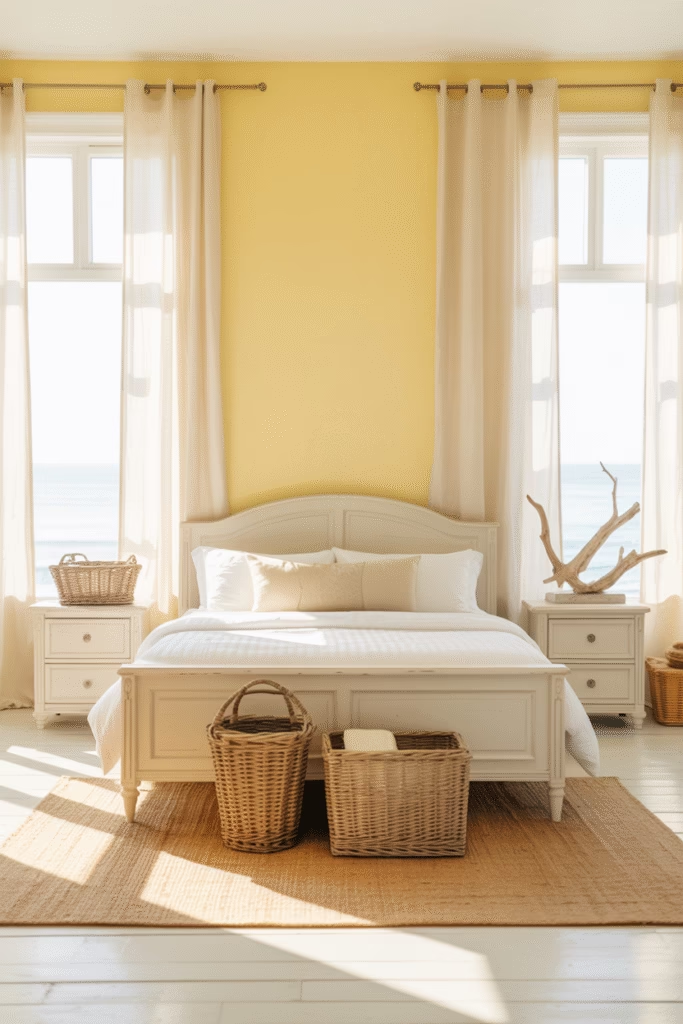
For a fresh, coastal-inspired look, pair lemon yellow walls with all-white furniture. I’m talking about a cleaner, brighter yellow here—something with cool undertones rather than warm.
White painted wood furniture keeps the room feeling airy. A white dresser, white bed frame, and white nightstands create a cohesive look. Add natural textures through jute rugs (180 x 240cm/6 x 8 feet works for most bedrooms), rattan baskets, and driftwood accessories.
This combination works brilliantly in small bedrooms because the white furniture doesn’t add visual weight. I used this in a 3m x 3.6m (10 x 12 foot) bedroom and it felt surprisingly spacious.
Keep window treatments simple—white linen curtains or bamboo blinds maintain the light, breezy feeling.
Dusty Yellow with Dark Wood
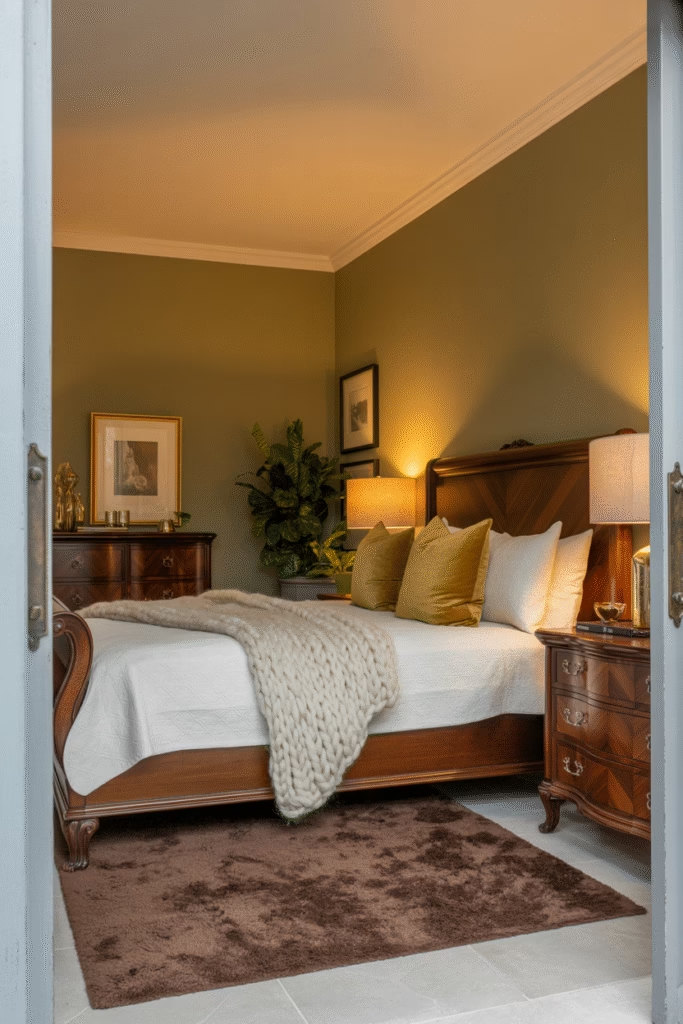
This is my choice for creating a cozy, enveloping bedroom. Use a dusty, muted yellow with gray or brown undertones on the walls. These colors often have names like “Stone Yellow” or “Cornsilk.”
Pair this with dark walnut or mahogany furniture. The contrast creates drama while the muted yellow keeps it from feeling too heavy. I outfitted a primary bedroom this way last spring with a dark wood sleigh bed and matching dresser, and the clients said it became their favorite room in the house.
Add texture through a chunky knit throw blanket in cream, velvet pillows in deep gold, and a plush area rug in charcoal or chocolate brown. Layer your lighting with table lamps that have warm-toned shades—they’ll cast a beautiful glow on the yellow walls.
Geometric Yellow Wallpaper Feature

If you’re feeling adventurous, geometric yellow wallpaper on one wall creates instant impact. I gravitate toward patterns with yellow plus one other color—yellow and white, yellow and gray, or yellow and soft blue work well.
The pattern size matters enormously. In bedrooms under 3.3 x 3.3m (11 x 11 feet), choose small to medium scale patterns. Larger rooms (3.6 x 4.2m/12 x 14 feet or bigger) can handle bold, oversized patterns.
Install wallpaper on the wall behind your bed, extending from floor to ceiling. Keep the other walls painted in the lightest color from your wallpaper pattern. I did this with a yellow and white chevron wallpaper in my daughter’s room, and five years later, it still looks fresh.
Pro tip: Order an extra roll. Wallpaper dye lots vary, and you’ll want extra for future repairs.
Sunny Yellow with Greenery
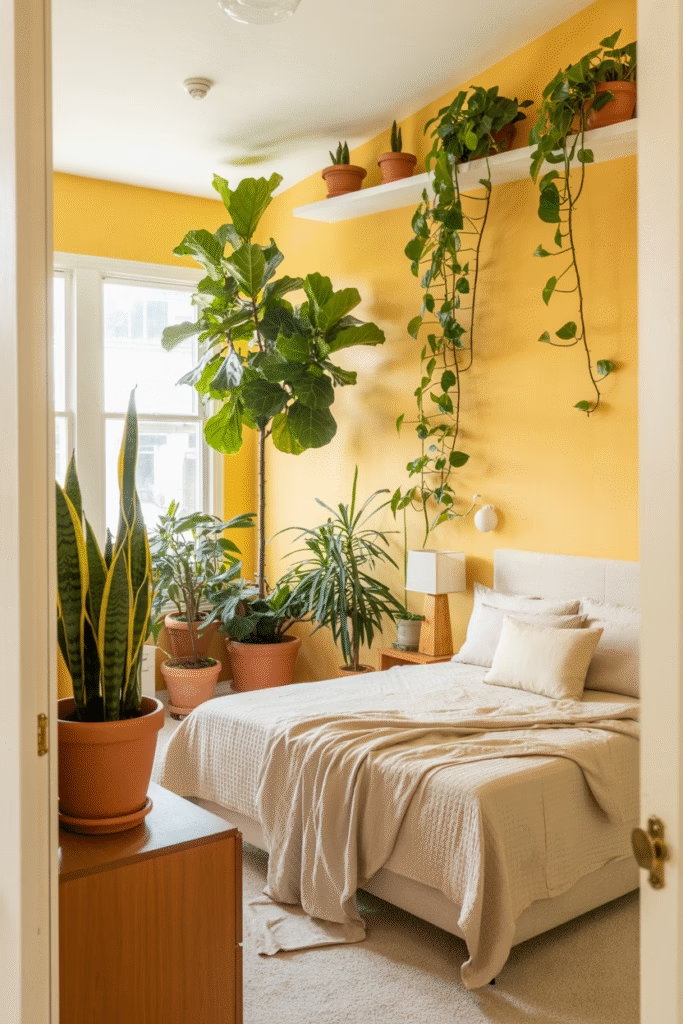
Yellow and green is nature’s perfect pairing. Paint walls in a sunny, cheerful yellow and bring in substantial greenery. I’m not talking about one small succulent—I mean multiple plants of varying heights.
Position a tall fiddle leaf fig (1.5-1.8m/5-6 feet) in a corner, add a pothos on a floating shelf, and place a snake plant on your dresser. The green leaves pop against yellow walls in a way that feels organic and fresh.
Choose planters in natural materials—terracotta, ceramic in white or cream, or woven baskets. Avoid plastic at all costs. I spend about ₹500-2,000 ($6-24) per planter, and they last for years.
This approach works best with mid-tone yellows that have slight green undertones. Test colors in the afternoon when natural light is most balanced.
Pale Yellow with Blush Pink Accents
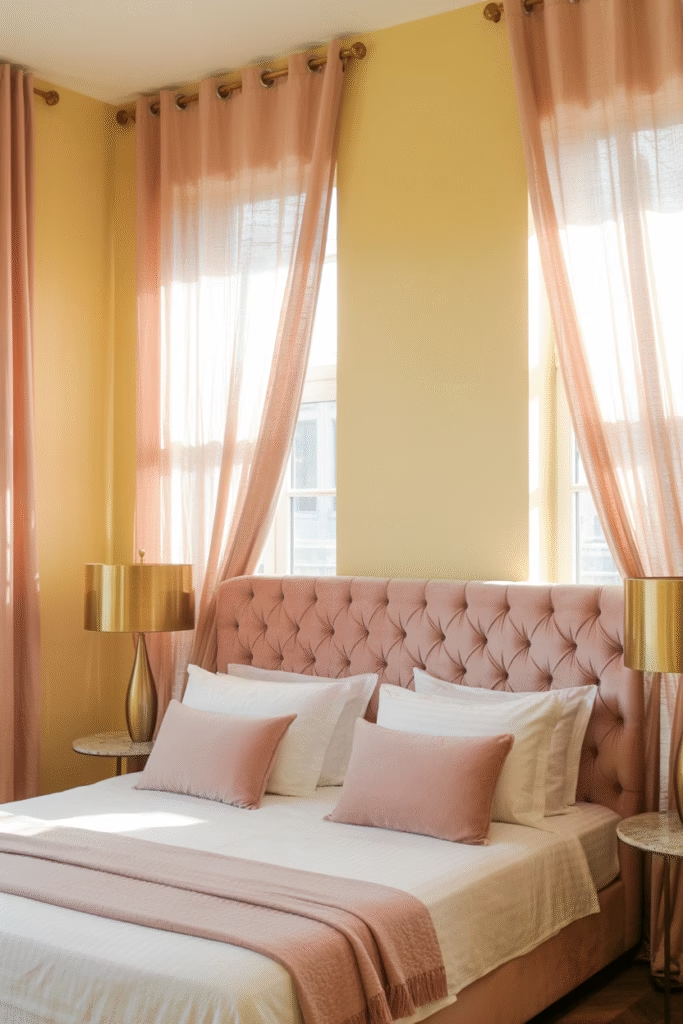
This softer combination creates a romantic, feminine space without being overly sweet. Paint walls in the palest yellow—something that’s almost cream but with a hint of sunshine.
Add blush pink through bedding, curtains, or an upholstered bench at the foot of the bed. The pink should be dusty rather than bright, with gray undertones. I layered pale yellow walls with a blush pink velvet headboard in my guest room, and the combination photographs beautifully.
Gold or rose gold hardware and light fixtures tie everything together. Replace standard silver drawer pulls with brushed gold versions—they cost around ₹300-600 ($3.60-7.20) each and make a surprising difference.
Keep at least 60% of the room neutral in white, cream, or light wood to prevent the space from feeling too pastel-heavy.
Two-Tone Yellow Walls

This technique adds architectural interest without actual molding or trim work. Paint the lower portion of your walls (up to about 90-100cm/36-40 inches) in a deeper golden yellow, and the upper portion in a pale butter yellow.
Install a simple chair rail or picture rail molding at the transition point, painted in white or cream. This breaks up the wall height and creates the illusion of taller ceilings in rooms that need it.
I used this in a bedroom with 2.4m (8 foot) ceilings, and by keeping the darker color on the bottom third, the room felt more balanced. The technique also makes sense historically—darker colors on the lower walls hide scuffs and wear better than light paint.
Furniture scale matters here. Keep larger pieces like dressers against the lighter upper section when possible.
Yellow Textured Walls with Minimal Decor
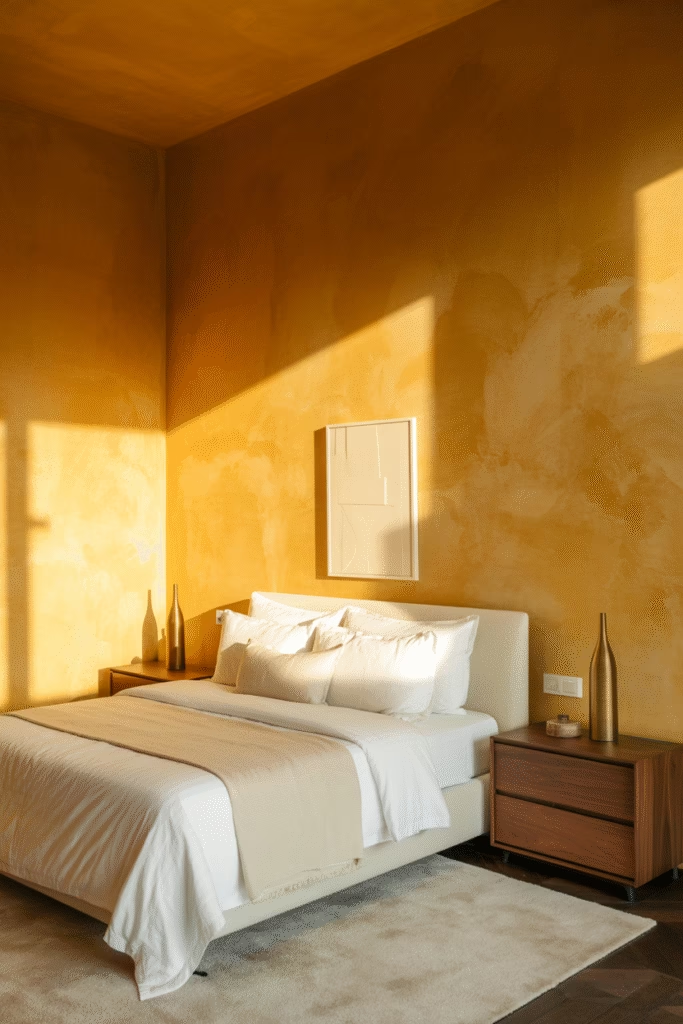
If you love texture, try a textured yellow wall finish. I’m talking about techniques like Venetian plaster, limewash, or even textured paint applied with a special roller.
The texture adds depth that makes yellow feel more sophisticated. A flat yellow can sometimes look one-dimensional, but texture creates subtle shadows and variation that’s incredibly beautiful as light moves through the day.
This is a more advanced technique. I typically hire a professional plasterer for this work—it costs ₹150-300 ($1.80-3.60) per square meter but the results are worth it. The walls become a focal point on their own, so you can keep decor minimal.
Pair textured yellow walls with simple, clean-lined furniture and very few wall decorations. Let the walls be the art.
Warm Yellow with Terracotta Details
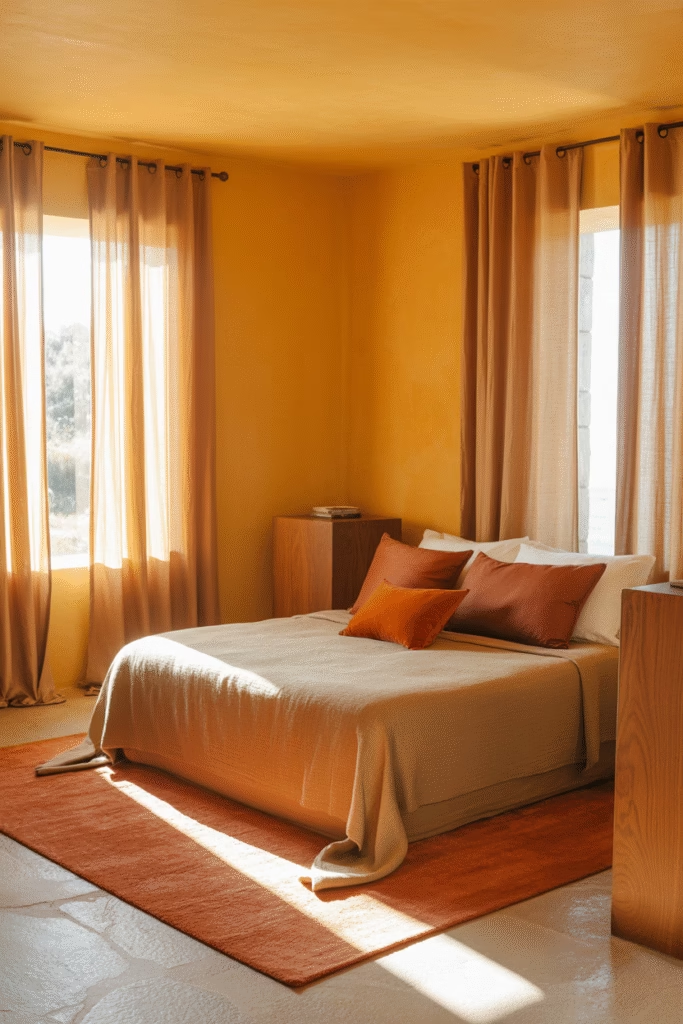
This earthy combination feels grounded and warm. Choose a yellow with orange undertones—think golden honey rather than lemon. Pair it with terracotta-colored textiles and accessories.
I love a terracotta-colored area rug (at least 180 x 240cm/6 x 8 feet) anchoring the bed, paired with terracotta linen curtains. Add throw pillows in burnt orange, rust, and warm brown. The overall effect feels like a Mediterranean villa.
Natural materials matter here. Stick to cotton, linen, wool, and jute for textiles. Choose solid wood furniture rather than painted or laminate pieces. Even your lamp bases should be ceramic, wood, or terracotta clay.
This color scheme works beautifully with concrete or polished concrete floors if you have them. The industrial element balances the warmth.
Soft Yellow with Black Accents
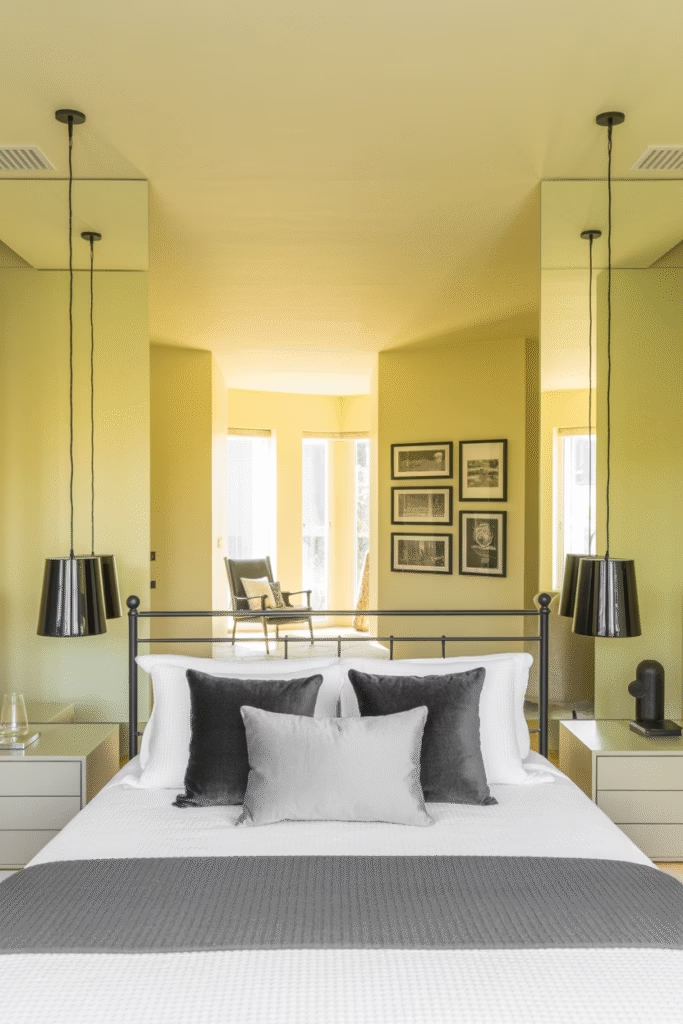
For a more dramatic, modern look, pair soft yellow walls with deliberate black accents. This isn’t about painting furniture black—it’s about strategic black elements that create contrast.
I incorporate black through lighting fixtures (a matte black pendant light over the nightstand costs around ₹3,500-7,000/$42-84), picture frames, and hardware. Maybe a black metal bed frame if you’re feeling bold.
The yellow should be pale and slightly warm—something that reads almost neutral. The black accents then provide punctuation marks that make everything else pop.
Keep this at about 10-15% black maximum. More than that and the room loses its sunny, cheerful quality. In my own bedroom, I have a black metal headboard, two black picture frames, and black light switches—that’s enough.
Graduated Yellow Ombre Effect
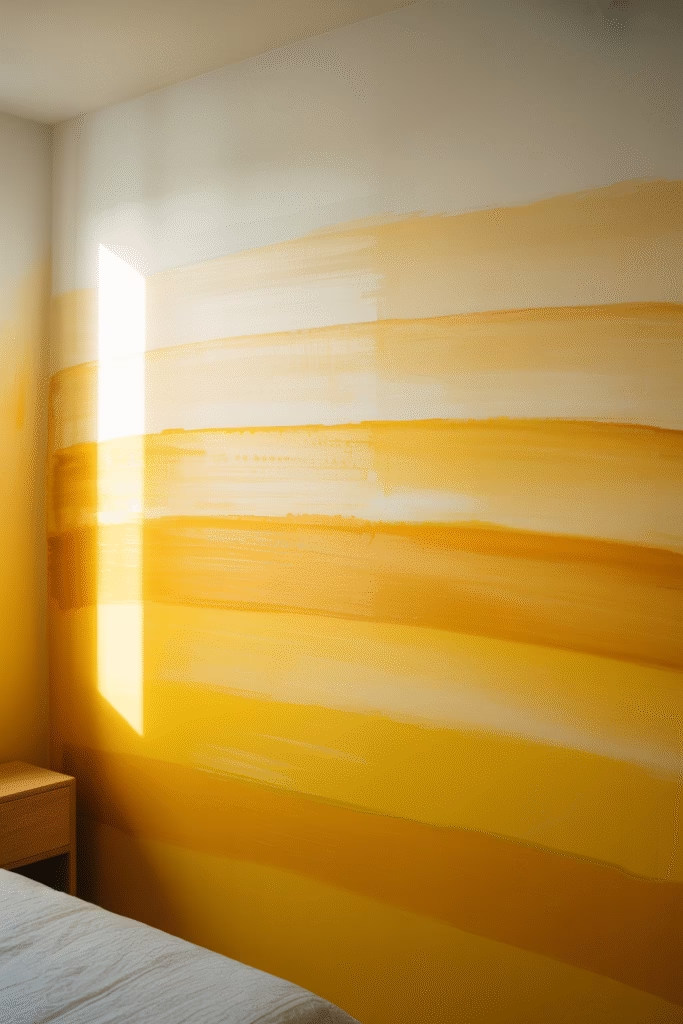
This is definitely an advanced technique, but the results are stunning. Create an ombre effect where yellow gradually lightens from a deeper tone at the bottom of the wall to nearly white at the ceiling.
You’ll need at least four shades of yellow paint in the same color family, each about 25% lighter than the previous. Starting at the bottom, paint horizontal bands and blend where they meet while the paint is still wet. This requires working in sections with a partner for timing.
I’ve done this twice—once successfully and once less so. The key is working in consistent 45-60cm (18-24 inch) bands and blending quickly. Don’t attempt this in humid weather or with slow-drying paint.
The effect makes walls feel like they’re glowing. It’s particularly beautiful in bedrooms with low ceilings because it draws the eye upward.
Cheerful Yellow with Multi-Colored Global Textiles
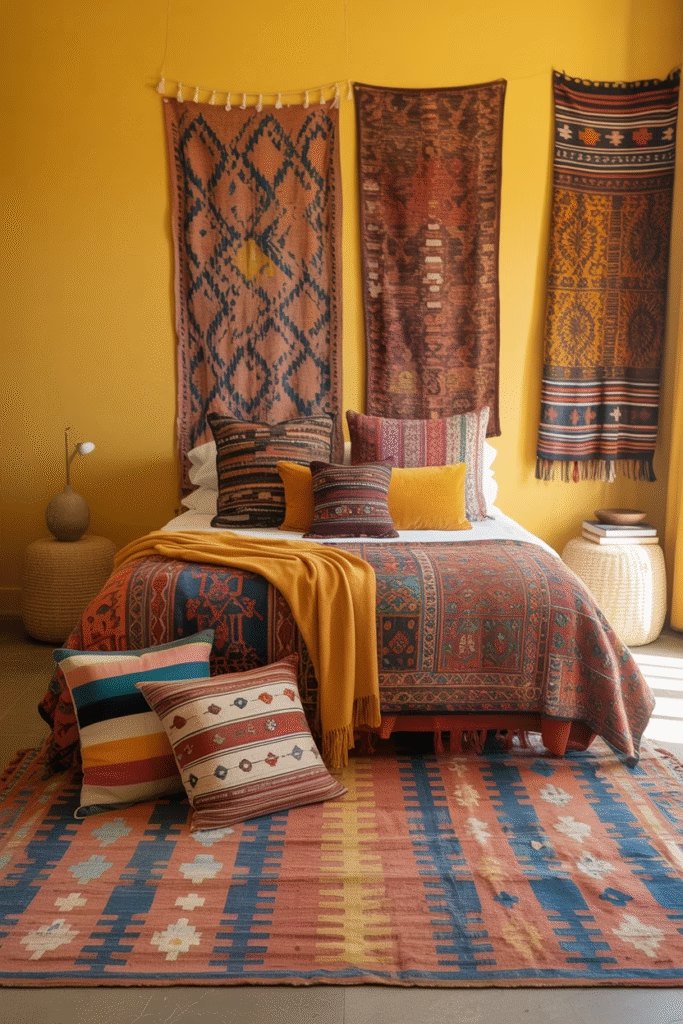
For maximalists who love color, yellow walls provide the perfect backdrop for vibrant, patterned textiles from around the world. I’m talking about Moroccan rugs, Indian block-print bedspreads, Turkish kilim pillows, and Mexican woven throws.
The yellow should be warm and mid-toned—bright enough to stand up to colorful patterns but not competing with them. Each textile you add should include at least a touch of yellow to tie everything together.
This style requires confidence and editing. I limit patterns to 3-4 maximum in the same space, and I make sure they vary in scale. A large geometric rug, medium floral bedding, and small ethnic print pillows work together. Three similar-sized patterns fight each other.
Start with the largest piece (usually the rug) and build your color story from there. Budget ₹15,000-40,000 ($180-480) for quality handmade textiles that will last decades.
FAQ
What’s the best shade of yellow for a bedroom?
Soft butter yellows and pale golden yellows work best for most bedrooms. I recommend testing Benjamin Moore’s “Hawthorne Yellow” or Sherwin Williams’ “Friendly Yellow” first. These have enough warmth to feel cozy but aren’t so bright they interfere with sleep. Avoid pure lemon yellows unless you’re going for a very specific coastal look.
Will yellow walls make a small bedroom look smaller?
Actually no—pale to mid-tone yellows reflect light and can make small bedrooms feel larger. I’ve used soft yellow in bedrooms as small as 2.7 x 3m (9 x 10 feet) successfully. The trick is keeping the ceiling white or very pale, which maintains the sense of height. Dark yellows or overly saturated shades can close in a small space, so stick to lighter versions.
How do I prevent yellow from looking too childish?
Layer in sophisticated materials and avoid primary color combinations. Pair yellow with charcoal gray, navy blue, or rich wood tones rather than bright red or blue. Choose textured fabrics like linen and velvet over shiny or cartoon-patterned textiles. Quality furnishings in classic styles keep yellow feeling grown-up and intentional.
What type of lighting works best with yellow walls?
Warm white bulbs (2700-3000K) complement yellow walls beautifully without making them look orange. I avoid cool white bulbs entirely in yellow bedrooms—they make the walls look greenish. Install dimmer switches on overhead lights so you can adjust brightness throughout the day. Budget around ₹1,500-3,000 ($18-36) per dimmer switch installed.
Can I use yellow in a bedroom that gets very hot?
Yes, but choose yellow shades with blue or gray undertones rather than orange undertones. Warm yellows can psychologically make a room feel warmer. I’ve found that dusty yellows, pale lemon yellows, or butter yellows with slightly cool undertones work well in hot climates. Pair them with plenty of white and natural materials to maintain a fresh feeling.
How often will I need to repaint yellow walls?
Quality yellow paint typically lasts 5-7 years before needing a refresh. Yellow can fade slightly in rooms with intense direct sunlight, so I recommend medium-quality paint at minimum (₹400-700/$4.80-8.40 per liter). Use a paint + primer combination for better coverage and longevity. In high-traffic areas, choose scrubbable eggshell or satin finish rather than flat matte.
Wrap Up
Yellow bedrooms get a bad reputation because people either go too bright or pick the wrong undertones for their space. But when you choose the right shade and pair it thoughtfully, yellow creates one of the most welcoming, energizing bedrooms you can have.
I’ve walked you through 15 approaches I’ve personally used or recommended to clients. Start with one technique that speaks to you maybe it’s soft butter yellow walls if you’re cautious, or that bold marigold accent wall if you’re feeling confident. Test your paint samples in different lighting conditions before committing. That step alone will save you from repainting later.
Remember that yellow works best when you balance it properly. Keep at least 40-50% of your room in neutrals, choose quality materials over trendy pieces, and don’t rush the process. A well-designed yellow bedroom takes time to layer correctly.

